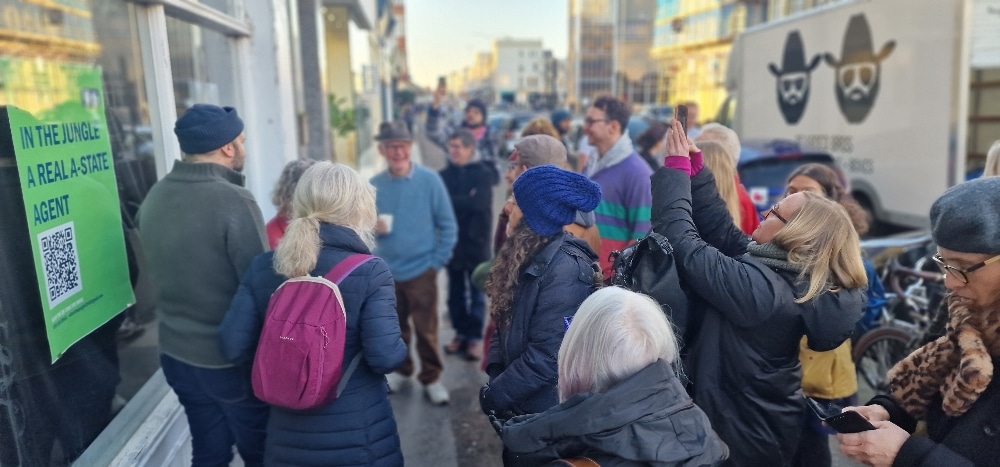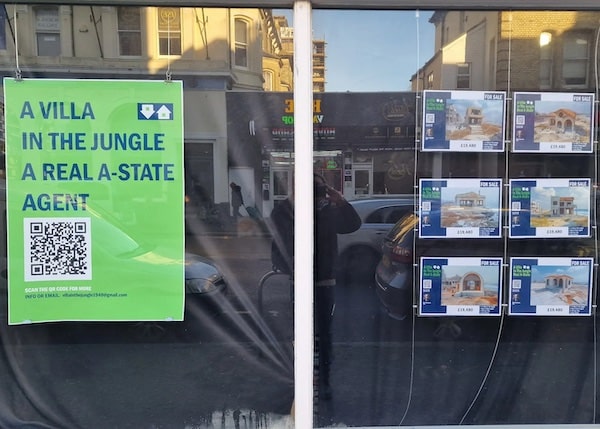A couple walk up to the display window of a glass shopfront sandwiched between two estate agents in central Hove on England’s south coast and look at window ads for properties for sale—and then, the penny drops.
The posters show a villa under construction in what appears to be the devastated Gaza war zone. Something is not right.
The cognitive jolt from the experience—visible on their faces—is a result of the politically charged artwork called Villa in the Jungle A Real A-State Agent by British-Israeli artist Gil Mualem-Doron.
Inside the shop, which is run by a local campaign group, are several installations and art exhibitions spread across three rooms.
Mualem-Doron’s work in Hove consists of a short film called Living the Dream and a separate installation featuring miniature villas on wooden plinths, a gold spray-painted log and broken Victorian tiles imprinted with Arabic mosaics scattered on the floor.
Visitors to the pop-up gallery, hosted by the Collective Action group in Hove, can watch the film juxtaposing real property videos of settlers in the occupied West Bank with shots of Israeli brutality towards Palestinians and destruction in Gaza.
The installation is adjacent to a moving memorial in a separate room, comprising the names of thousands of Palestinian children killed by Israel in Gaza, created by activists from Brighton and Hove.
The estate agent-style “ads” for villas in the ruins of Gaza are in the heart of Hove—a city that has seen many protests and clashes between pro-Israel and pro-Palestine groups, and even more so since 7 October 2023.

People attend the shop in Hove to see Mualem-Doron’s installation Villa in the Jungle in southern England (Photo: Gil Mualem-Doron)
Mualem-Doron’s work has also been shown in places such as Tate Modern, Turner Contemporary and the Southbank Centre.
For a recent exhibition in London’s P21 Gallery, the artist collaborated with historian Ilan Pappe, Ronnie Kasrils—the anti-apartheid resistance leader and former African National Congress (ANC) minister in Nelson Mandela’s first post-apartheid government—and surgeon Ghassan Abu-Sitta.
Living the Dream
As he explains, the fake ads for villas amid Israel’s destruction of Gaza are actually based on a real Israeli estate agent that began promoting property on Gaza’s beaches during the first months of the war in late 2023.
About two or three months into the Gaza war, an estate agent in Israel called Hari Zahav [Mountain of Gold] created a fake campaign to sell new villas on Gaza beach and basically restart the settlements as a kind of a joke. I don’t know how they could laugh at that time.
The ads went viral and received global media coverage, he explains.
It was a kind of wishful thinking. I started following them to see what they were up to, and they started posting [on Instagram] short video clip interviews with [property] sellers in the West Bank, describing their amazing villas and big gardens, etc, knowing the real situation in the West Bank—at least for the Palestinians—is nothing like that. So that was another entry point for this project.
Israel built illegal settlements in the West Bank and Gaza after the region was seized in the aftermath of the 1967 war against Egypt, Syria and Jordan.
Gaza’s settlers were removed when Israel withdrew at the end of the Second Intifada in 2005.
Living the Dream also contains short clips from the award-winning Jonathan Glazer film Zone of Interest, set in the Auschwitz death camp.
Last year, Mualem-Doron says he watched the film and saw parallels between it and the Gaza property ads and video clips of settler properties in the West Bank.
There was a segment in the film that reminded me of these interviews with the settlers.
Taking them around the big house and the garden, and there’s a swimming pool, barbecue place, etc… There’s a very similar scene in Zone of Interest.
The whole idea of the Zone of Interest is less ideological per se, but it’s just a lower middle class woman who wanted a big house with a garden. The fact that it’s attached to Auschwitz, she didn’t really care about.
Banality of evil
Mualem-Doron qualifies that Israeli settler colonialism is not the same as the Holocaust, but the mindset is comparable.
I’m looking at it from the Jewish point of view of being completely oblivious—either purposely or not—of the situation just beyond the wall of the settlement.
It’s kind of connected to what Hannah Arendt talked about ‘the banality of evil’. It’s really banal.
It’s sort of two timelines, two parallel universes, you see all these happy settlers with their nice villas, etc, and then you see what is just behind the wall of settlements”—Palestinians living under a brutal occupation.
Most of the film is set in the occupied West Bank, then it moves into Gaza, with footage of the devastation resulting from the 2023-2024 Israeli assault.
“Because Gaza is not part of the Holy Land, it wasn’t part of Judea and Samaria [the biblical name for the West Bank used by Israelis]; it was Philistine, a different nation; it wasn’t ideological,” Mualem-Doron says.
He explains the distinction between the thinking motivating settlements in the West Bank and Gaza.
The other way of selling Gaza properties to non-ideological people is because it’s an amazing place to live because you’re living on the beach with these amazing views.
At the start of the war, he says Israeli soldiers who had worked for the estate agents and others who knew about it were filming themselves demolishing houses, saying:
We are going to build the settlements.
Middle East Eye contacted Hari Zahav about the campaign but had not received a reply by the time of publication.
It’s something that’s completely fantastical but that’s now being realised: the whole of northern Gaza being completely flattened could easily be prepared for new settlements.
First, you have the ideological settlers wanting to return, then you have the Generals’ Plan to ‘cleanse’ the whole north Gaza, so one thing leads to another.
Now, we are talking there’s going to be a ceasefire, but you don’t know if the second stage will take place, and you have the radical right in Israel who don’t want it to take place.
If the IDF [Israeli army] withdraw from Gaza, their dream to recreate the settlements is gone, at least for now.
Dream postponed?
For Mualem-Doron, there is a direct line linking the European colonial slave economy and the ideology of racism that emerged over time to justify it, as well as the racial economy of Israel’s occupation of the West Bank and the world view of even non-ideological settlers.
Settlers have to justify themselves… You know, you have refugee camps also in the West Bank, (with) all the atrocities and apartheid regime there.
Although born in Britain, the artist grew up in Israel, where his emigre Jewish parents (his father was from Iraq, his mother Bulgaria) moved in the late 60s.
He returned to the UK in the wake of Benjamin Netanyahu’s first election victory in the late 90s.
I was in London for 10 years before returning in 2009. It was exactly the time he was out of [being] prime minister.
In Israel, he had worked as a journalist, writing about historic Palestinian communities in Israel and the villages erased since 1948, when the state of Israel was created on Palestinian land.
I learnt about the remnants of some Palestinian village at the edge of old Tel Aviv, and I did a campaign against demolishing it.
He did not succeed; the city demolished the remains of the village and put a grass lawn over it.
Grass is a colonial element, too. It is a thing you have in kibbutzim, in settlements… Grass in the context of the Middle East is all fake because it’s not native, and it’s completely unenvironmental because it uses so much water.
Again, it’s a colonial legacy. You have it in the West Bank, where the Palestinian villages don’t have water but the nearby settlements have grass and swimming pools.
Colonial legacy
His new work also references the British colonisation of Palestine, as evidenced by the fake lawn and the Victorian tiles imprinted by Arabic mosaics.
Mualem-Doron says: “Both the grass and the whole image of the Villa in the Jungle begins with the British colonising Africa.
It’s colonial imagery; it’s not a Jewish or Zionist invention; it comes from Europe, and it was taken by European Jews coming to Palestine and feeling out of place.
Much of Mualem-Doron’s work has been a kind of Situationist sleight of hand, using art to reach places that conventional protest cannot.
In the early 2010s, back in Israel, he put on an event in Jaffa where he posed as a real estate agent and invited people to buy old Palestinian houses.
I built small models of houses for sale, with a big sign behind me and a telephone number, with a white suit, a megaphone shouting: ‘Arab houses for sale.’ The dream of every Israeli is to own an Arab house.
The goal was to provoke thoughts among Israelis about its history and its dispossession of Palestinians.
I came from activism, and there are things you can do in demonstrations, you know, but it’s very limited in terms of the conversation.
This kind of project is really open in terms of conversation, even with people who might not agree with you.
The artist hopes the piece will remind the British people that “the mess in the Middle East, not only in Palestine, is caused by colonialism and imperialism”.
Villa in the Jungle shares the space with an exhibition of images of local pro-Palestinian protests by photographer Natasa Leoni, alongside photos from Brighton Queers for Palestine and the Jewish pro-Palestine group Na’amod of different street actions against the genocide in Gaza.
On the other side of the room is a series of portraits of Palestinians from Gaza, each overlaid by their personal testaments, from the international solidarity project We Are Not Numbers.
Mualem-Doron describes how he hopes people will see the work:
When I imagine [the Gaza villa ads] in the window of the shop, I imagine people who never go to a pro-Palestinian demo, not even if they are against it [but are] just not interested in the subject, and they are just looking for a house, and you tap them on the shoulder and say look this is also happening.

